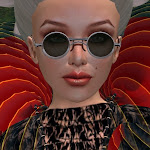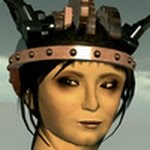On January 27th of this year, the Not Possible in Real Life (NPIRL) group launched an initiative to identify and extend invitations to people we admire and whom we believe would derive pleasure in discovering the creation and communication tools available to them in the 3D virtual world known as Second Life. There is certainly a very appreciative - and growing - audience waiting for them. It is our hope that they will take us up on our shout out and make the pilgrimage to check it out. Today, I welcome this introduction to Dr. Ruth Ballard by guest blogger and NPIRLer Bjorlyn Loon.
by Bjorlyn Loon
When geneticist Ruth Ballard went on vacation to Africa, she had no idea she would come home with a DNA database as a souvenir. On a climb of Mount Kilimanjaro in 2001, Ballard found herself wondering whether the Tanzanian population had been adequately tested for DNA, so she took home samples from the native porters assisting on her journey.
Upon her return to the United States, Ballard contacted the Tanzanian government in Dar es Salaam to request permission to conduct more extensive studies of the many tribes in the nation. To her surprise, the government approved her application to begin testing the Maasai, but with a catch: officials asked that Ballard begin the process of mapping the country's entire population of more than 30 million people, and also that she train Tanzanians in the forensic techniques required to use the database effectively.
Dr. Ruth Ballard in the company of Maasais
While Americans tend to think of forensic genetics in terms of crime scene investigations, the focus in many nations is on establishing paternity. In areas where people transit between remote rural villages and the cities, children and spouses may be left behind. To obtain means of support for dependents, the establishment of a full map of genetic markers for a population and subsequent forensic DNA testing of individuals enables governments to identify a child's natural parents.
This humanitarian goal has provided a focus for Ruth's efforts. She returns to Africa during the summers on "saliva safaris" to collect DNA samples that reflect the great human genetic and cultural diversity of the subcontinent.
But the challenge of training African scientists has proved to be more difficult.
While Ballard has developed a forensic biology concentration for undergraduates at California State University Sacramento (CSUS) (where she serves as an Associate Professor for the Department of Biological Sciences), it is difficult to provide the same kind of experimental experience to people on another continent.
Fortunately, Ballard's efforts have coincided with a proliferation of forensic and genetic science opportunities in Second Life. The CSI:NY programs (teleport directly from here) as well as islands such as Genome (teleport directly from here) in the SciLands archipelago would seem to offer a ready-made training ground for Real Life scientists. 
Photograph courtesy of CSUS
A true explorer, Professor Ballard seems like a natural to introduce to our virtual world, and involving her colleagues in Africa to Second Life would be an added joy.
Like artists, scientists are benefiting from the opportunity to use Second Life as a distance-spanning collaborative workspace and educational tool. Just a couple of notable examples:
* Dr. Bob Amme and Jeff Corbin of the Science School islands are constructing a model nuclear reactor to teach students from Denver University how to manage nuclear waste. Via a $200,000 grant from the Nuclear Regulatory Commission, the Second Life installation will engage students in virtual nuclear experimentation, sans the real-life risks of radioactive contamination and terrorist exploitation.
* In February, NASA streamed their Next Generation Exploration Conference into Second Life. Over four days, Second Life residents literally sat at the table to offer ideas and expertise as an integral part of conference working groups. The program is designed to give a boost to potential lunar entrepreneurs in anticipation of setting foot on the moon in the coming decade.
But much of science is still in the dark about the value of virtual worlds. I hope that Professor Ballard will be the first of many scientists recruited by NPIRL.
You can hear Ruth Ballard's story on KXPR's Insight, the Sacramento National Public Radio affiliate, here.
Thursday, March 13, 2008
Dr. Ruth Ballard: Virtual worlds and their tools can be used for science
Posted by
Bettina Tizzy
at
2:00 PM
![]()
Labels: Bjorlyn Loon, CSI:NY, CSUS, DNA, Dr. Ruth Ballard, forensic techniques, genetics, Genome, NASA, Not Possible IRL, NPIRL, science, Second Life, Tanzania








0 comments:
Post a Comment